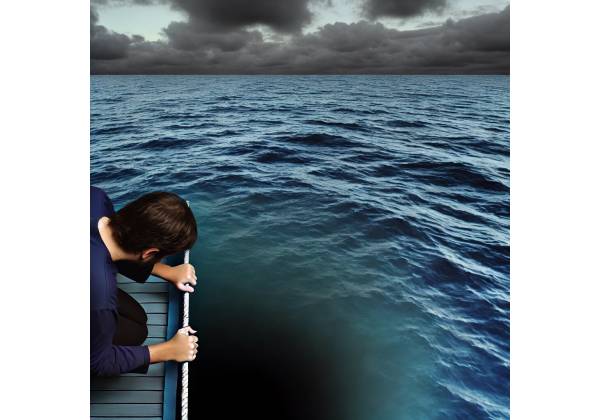
What is anthropophobia?
Anthropophobia is a strong, irrational fear of people or social interactions that causes people to avoid situations in which they may encounter others. The term is derived from the Greek words “anthropos” (meaning human) and “phobos” (meaning fear). While it is normal to be nervous or shy in certain social situations, anthropophobia goes beyond that. It frequently causes intense anxiety or panic in the presence of others, even in everyday situations. This phobia is frequently confused with social anxiety disorder, but it is usually more severe, causing people to isolate themselves completely in order to avoid any form of human contact.
People with anthropophobia may be afraid of being judged, humiliated, or rejected by others. They may also be overwhelmed by the prospect of interacting with large groups or even individuals in close proximity. This fear can limit their ability to participate in normal activities such as going to work, school, or social gatherings, significantly lowering their quality of life.
Regardless of severity, anthropophobia can be effectively managed and treated with the appropriate interventions. Understanding the symptoms, causes, and treatment options for anthropophobia can help people regain control of their lives and reduce the overwhelming fear that comes with human interactions.
What are the symptoms of anthropophobia?
The symptoms of anthropophobia can manifest in a variety of ways, affecting people both physically and emotionally. These symptoms are frequently triggered by the mere thought of being in social situations or interacting with others, and they can worsen when confronted with actual human contact. Recognizing the full spectrum of symptoms is critical for understanding how anthropophobia affects a person’s daily life.
Physical Symptoms
When people with anthropophobia encounter others or anticipate social situations, their bodies may react with increased anxiety. These physical symptoms are part of the body’s natural “fight or flight” response, which is activated when it perceives human interaction as a threat.
- Rapid heartbeat (tachycardia): The heart rate often rises significantly when confronted with the prospect of interacting with others.
- Shortness of breath: Difficulty breathing or feelings of suffocation are common during times of high anxiety.
- Sweating: Excessive sweating can occur, particularly when people feel surrounded or trapped by others.
- Trembling or shaking: Fear of human interaction can cause uncontrollable shaking, especially in the hands and legs.
- Dizziness or lightheadedness: People with anthropophobia frequently report feeling faint or unsteady, particularly when forced into crowded or enclosed spaces.
- Chest pain or tightness: Anxiety from anthropophobia can cause chest tightness or discomfort, similar to the symptoms of a heart attack.
- Nausea or upset stomach: Fear can cause gastrointestinal problems, such as nausea, stomach pain, or a general feeling of unease.
Emotional and Psychological Symptoms
Anthropophobia also has a negative impact on emotional and psychological well-being, causing individuals who are afraid of social interaction to be constantly distressed. These symptoms can range from mild discomfort to severe emotional responses.
- Overwhelming fear of people: People with anthropophobia frequently experience intense fear of others, whether in group settings or one-on-one interactions.
- Panic attacks: In severe cases, fear of human contact can cause panic attacks, which are characterized by a racing heart, difficulty breathing, dizziness, and an overwhelming sense of dread.
- Avoidance behaviors: To cope with their fear, many people with anthropophobia go to great lengths to avoid any interaction with others, such as isolating themselves at home or refusing to attend social events.
- Anticipatory anxiety: The mere thought of meeting others can cause significant anxiety, leading people to cancel plans or avoid situations where they may have to interact with others.
- Extreme shyness or embarrassment: People with anthropophobia may be overly self-conscious in social situations, fearing judgment, humiliation, or rejection.
- Depersonalization or detachment: During times of high anxiety, people may feel disconnected from their surroundings or have a sense of unreality, as if they are watching themselves from outside.
Behavioral Symptoms
People with anthropophobia frequently engage in specific behaviors to avoid human interaction as a result of their fear. These behaviors can become habitual, significantly disrupting daily functioning.
- Social withdrawal: Many people with anthropophobia completely isolate themselves from social situations, refusing to leave their homes or interact with others.
- Avoidance of public places: People who are afraid of meeting new people may avoid places like restaurants, stores, and parks.
- Reliance on technology: Some people may avoid face-to-face interactions by using digital communication tools like text messages or social media.
- Excessive planning: Before leaving their home, people with anthropophobia may overplan their routes and schedules to reduce the likelihood of encountering others.
Cognitive symptoms
People suffering from anthropophobia frequently exhibit cognitive distortions. People’s intense fear stems from these irrational thoughts and beliefs:
- Catastrophic thinking: People may believe that any interaction with others will end in humiliation, rejection, or conflict.
- Hypervigilance: Individuals with anthropophobia are constantly scanning their surroundings for people or social interactions, keeping a close eye out for perceived threats.
- Overestimation of risk: They may overestimate the likelihood of negative events occurring in social situations, such as believing that others are constantly judging or criticizing them.
Understanding these symptoms is critical for identifying anthropophobia and receiving appropriate treatment. The physical, emotional, and cognitive toll that anthropophobia exacts on individuals can have a significant impact on their quality of life, making it difficult to function in everyday situations.
Causes and Risk Factors for Anthropophobia
Anthropophobia is often caused by a combination of psychological, environmental, and biological factors. While each individual’s experience with anthropophobia is unique, there are some common causes and risk factors that contribute to its onset.
Psychological Causes
- Traumatic social experiences: Negative social experiences are a common cause of anthropophobia. Individuals who have been bullied, humiliated, or socially isolated may develop a strong fear of human interaction. These previous experiences can instill a deep belief that all social interactions are dangerous or harmful.
- Learned behavior: Phobias can arise from observing others. For example, if a parent or close family member fears or avoids social interactions, a child may mimic those behaviors, reinforcing a pattern of social fear.
- Social anxiety disorder: In some cases, anthropophobia manifests as a severe form of social anxiety. While social anxiety is a fear of specific social situations, anthropophobia is a more widespread and debilitating fear of people in general.
Biological and Genetic Factors
- Genetic predisposition: Anxiety disorders, including anthropophobia, may have a genetic component. Individuals with a family history of anxiety disorders or phobias are more likely to develop anthropophobia, indicating a genetic link to the condition.
- Brain chemistry: Imbalances in neurotransmitters like serotonin and dopamine can affect how people process fear and anxiety. These chemical imbalances may make some people more prone to developing phobias, including anthropophobia.
Environmental Factors
- Cultural and societal influences: Cultural norms or societal pressures may contribute to the development of anthropophobia. Individuals who grow up in environments where social interactions are closely monitored or where there is a strong emphasis on conformity, for example, may experience overwhelming pressure in social situations, leading to fear and avoidance.
- Isolation during critical developmental stages: People who grow up in socially isolated environments or who spend long periods of time alone, such as during childhood or adolescence, are more likely to develop anthropophobia due to a lack of exposure to positive social interactions.
Risk Factors
Several factors can increase the risk of developing anthropophobia, including:
- History of trauma or bullying in social settings.
- A family history of anxiety or phobias.
- Presence of additional mental health disorders, such as depression or generalized anxiety disorder.
- Long-term social isolation or lack of socialization during the developmental years.
Understanding the causes and risk factors of anthropophobia can assist individuals and healthcare providers in addressing the source of the phobia and developing more effective treatment plans.
How Is Anthropophobia Diagnosed?
A mental health professional must conduct a thorough evaluation in order to diagnose anthropophobia. The diagnostic process entails evaluating the individual’s symptoms, determining the severity of their fear of people, and ruling out any other possible causes. Accurate diagnosis is critical for developing an appropriate treatment plan based on the individual’s needs.
Diagnostic Criteria
Anthropophobia is typically classified as a specific phobia in the **Diagnostic and Statistical Manual of Mental Disorders (DSM-5). To meet the anthropophobia criteria, the following conditions must be present:
- Persistent and excessive fear of people that outweighs the actual threat.
- Avoidance behaviors that disrupt daily life, such as refusing to attend work, school, or social events.
- Symptoms last six months or more, with anxiety or panic occurring immediately upon meeting others or in anticipation of social interactions.
Clinical Interviews
Clinical interviews are used by mental health professionals to assess people’s fear of social interaction. During these interviews, the clinician will inquire about the individual’s symptoms, triggers, and any traumatic events or experiences that may have contributed to the onset of anthropophobia. The goal is to understand the severity of the phobia and how it affects the individual’s life.
Psychological Assessments
Standardized assessments, such as the Social Phobia Inventory (SPIN) or Fear of People Questionnaire (FPQ), can be used to quantify an individual’s fear and anxiety in social settings. These assessments assist clinicians in determining the extent to which anthropophobia impairs an individual’s emotional, social, and psychological functioning.
Rules Out Other Conditions
Because anthropophobia has symptoms similar to other anxiety disorders, it’s critical to rule out conditions like social anxiety disorder, agoraphobia, generalized anxiety disorder (GAD), or post-traumatic stress disorder (PTSD). A thorough evaluation ensures that the diagnosis is unique to anthropophobia and not part of a larger anxiety disorder. This differentiation is critical for creating an effective and targeted treatment plan.
The Effects of Anthropophobia on Daily Life
Anthropophobia can have a profound and far-reaching impact on many aspects of a person’s life, frequently causing significant social, professional, and emotional difficulties. People’s overwhelming fear of others can cause them to withdraw from society, resulting in a cycle of isolation that worsens over time.
Social Isolation and Loneliness
Anthropophobia has a significant impact on social isolation. Individuals with this phobia frequently avoid situations where they might encounter others, resulting in:
- Complete avoidance of social gatherings: This includes skipping events like family functions, weddings, and public gatherings with people.
- Difficulty forming or maintaining relationships: Because of their intense fear of interaction, people suffering from anthropophobia may find it difficult to form meaningful personal relationships, whether romantic or platonic.
- Loss of existing relationships: Over time, avoiding social interactions can cause friendships and familial bonds to break down, resulting in loneliness and emotional distress.
Professional and Educational Barriers
Anthropophobia can also impair an individual’s ability to succeed in academic or professional settings. Many aspects of work and school necessitate interaction with others, which can be overwhelming for people with this phobia. Some of the common professional and educational challenges are:
- Avoiding the workplace or school: Fear of human interaction may prevent individuals from attending work or school, resulting in job loss, academic failure, or career stagnation.
- Inability to collaborate with colleagues or classmates: Many jobs and academic programs require teamwork or group projects, but anthropophobia may prevent people from participating in these important aspects, limiting their success.
- Restricted career options: People with anthropophobia may restrict their career options in order to avoid jobs that require frequent human interaction, such as customer service or team-oriented positions. This restriction may limit career advancement opportunities.
Emotional and Psychological Toll
The ongoing fear and isolation that accompany anthropophobia can have a negative impact on a person’s mental and emotional health. Some of the most common emotional consequences are:
- Chronic anxiety: Constant worry about meeting others or navigating social situations can result in persistent anxiety, which may worsen over time.
- Depression: Prolonged isolation, feelings of loneliness, and an inability to participate in normal social activities can all lead to depression, especially if the person feels trapped by their phobia.
- Low self-esteem: Failure to interact with others or maintain relationships can lead to feelings of inadequacy, shame, and a diminished sense of self-worth.
Everyday Limitations
Even routine daily activities can be difficult for someone with anthropophobia. Fear of human interaction can interfere with simple tasks such as:
- Shopping or running errands: People who are afraid of meeting new people may find it difficult to complete necessary tasks such as grocery shopping, banking, or attending appointments.
- Using public transportation: For people with anthropophobia, crowded public spaces such as buses, trains, or subway stations can cause significant anxiety, making it difficult to travel.
- Participating in outdoor activities: A person’s fear of encountering strangers in parks, on the street, or in other public places may limit their ability to enjoy outdoor recreation or leisure activities.
Understanding how profound anthropophobia can be in daily life emphasizes the importance of seeking effective treatment. Without intervention, fear of human interaction can lead to a lower quality of life and prevent people from participating in activities that provide fulfillment and connection.
Top Treatment Options for Anthropophobia
Anthropophobia can be overwhelming, but it is a treatable condition. Effective interventions, such as therapy, medication, and self-help strategies, can help people overcome their fear of people and reclaim control of their lives. The treatment for anthropophobia focuses on addressing the underlying causes of the phobia, reducing anxiety responses, and assisting individuals in developing confidence in social situations.
Cognitive-Behavioral Therapy (CBT)
Cognitive Behavioral Therapy (CBT) is widely regarded as one of the most successful treatments for anthropophobia. CBT assists individuals in identifying and challenging the negative thought patterns and beliefs that contribute to their fear of human interaction.
- Cognitive restructuring: This technique entails assisting individuals in reframe their irrational fears of people and social situations. For example, the therapist works with the individual to challenge thoughts like, “Everyone is judging me,” and replace them with more realistic beliefs, such as, “Most people are focused on their own activities, not on me.”
- Exposure therapy: Exposure therapy is a key component of cognitive behavioral therapy for anthropophobia, in which people gradually confront their fear of people in a safe and supportive environment. Exposure starts with less intimidating social situations, like being in the same room as a small group, and gradually progresses to more challenging interactions. This gradual exposure helps people become desensitized to their fear, allowing them to interact with others without experiencing overwhelming anxiety.
- Behavioral experiments: During CBT, people may conduct behavioral experiments to test their beliefs about social interactions. For example, they may purposefully engage in a brief conversation with a stranger to gather proof that their fears are frequently unfounded.
Mindfulness-Based Stress Reduction(MBSR)
Mindfulness-Based Stress Reduction (MBSR) is a therapeutic approach that assists people in managing anxiety by staying present and focused on the present moment rather than becoming overwhelmed by their fear of social interactions.
- Mindfulness meditation: Mindfulness exercises help people stay present in the moment, reducing the tendency to overreact or anticipate negative outcomes in social situations.
- Breathing and relaxation techniques: MBSR teaches controlled breathing and relaxation exercises that can be used in times of anxiety to help people manage their physical symptoms and remain calm in social situations.
Virtual reality exposure therapy (VRET)
Virtual Reality Exposure Therapy (VRET) is a new treatment for anthropophobia that simulates social interactions through virtual environments. This type of therapy enables people to confront their fear of people in a secure and controlled digital environment.
- Simulated social settings: VRET creates realistic virtual scenarios in which people can practice interacting with others, such as walking down a crowded street or attending a virtual party. These simulations can be customized to the individual’s fear level and gradually intensified.
- Safe and gradual exposure: VRET allows people to confront their fears at their own pace, helping them gain confidence before moving on to real-life social interactions.
Medications
In some cases, medication may be recommended to help manage anthropophobia symptoms, especially if the individual suffers from severe anxiety or panic attacks. Medications are typically used in conjunction with therapy, rather than as a standalone treatment.
- Selective serotonin reuptake inhibitors (SSRIs): SSRIs, like fluoxetine (Prozac) or sertraline (Zoloft), are frequently used to treat anxiety and depression. These medications regulate serotonin levels in the brain, which improves mood and decreases fear responses.
- Benzodiazepines: To treat acute anxiety in the short term, benzodiazepines such as lorazepam (Ativan) or diazepam (Valium) may be prescribed. However, because of the risk of dependency, these medications are rarely recommended for long-term use.
- Beta-blockers: Beta-blockers, such as propranolol, can help manage physical symptoms of anxiety, such as racing heartbeat or trembling, especially when people expect to interact with others.
Support Groups and Social Support
Support groups provide a space for people with anthropophobia to connect with others who understand their situation and share coping strategies. These groups can help alleviate feelings of isolation while also providing valuable insights into how to manage social anxiety.
- Peer support: Group members can provide encouragement, share personal experiences, and foster a sense of community, which can be especially beneficial for people who feel isolated due to their fear of people.
- Group therapy: In some cases, group therapy led by a mental health professional can help people practice interacting with others in a safe and structured setting.
Lifestyle Changes and Self-Help Strategies
In addition to formal treatment, lifestyle changes and self-help strategies can help people manage anthropophobia in their daily lives.
- Regular exercise: Physical activity has been shown to lower anxiety by releasing endorphins and improving overall mood. Regular exercise can also be a healthy way to relieve stress and anxiety.
- Balanced diet and adequate sleep: Eating a healthy diet and getting enough sleep are critical for managing anxiety and emotions.
- Gradual exposure to social situations: People can take small steps toward exposure in their daily lives, such as spending short periods of time in public places or briefly interacting with people they trust.
Individuals suffering from anthropophobia can improve their overall quality of life by combining therapeutic approaches, medications (if necessary), and lifestyle changes.










